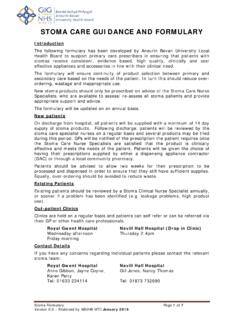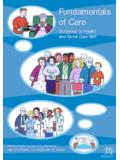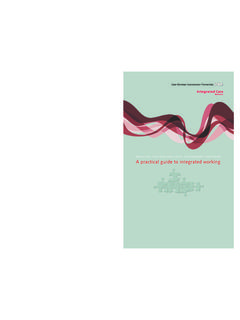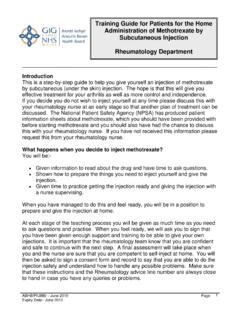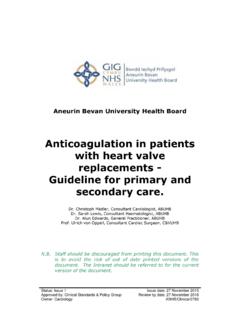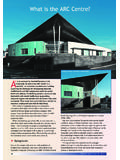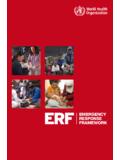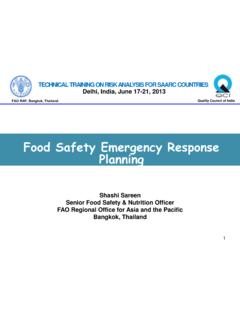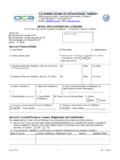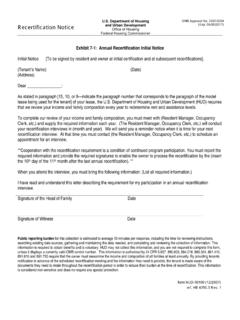Transcription of INITIAL OPERATIONAL RESPONSE TO A CBRN INCIDENT
1 INITIAL OPERATIONAL RESPONSE TO A CBRN INCIDENT SEPTEMBER 2013 V OPERATIONAL RESPONSE TO A CBRN INCIDENT SEPTEMBER 20133 INDEXF oreword 4 Essential Information 5 Introduction 6 CBRN First Responder Flowchart 7 Identify a Potential CBRN INCIDENT 8 Steps 1, 2, 3 Plus 8 INITIAL Call Handling 9 Advice to callers - Life Saving Actions 9 Control Room Supervisor - INITIAL Command & Control, Specialist Advice 10 First Responders All emergency services 11 INITIAL Information Situation Reporting 11 Joint Dynamic Hazard Assessment 12 Life saving actions 14 Casualty Movement 15 Rescue 16 Agency Specific Risk Assessment 16 Disrobe 18 Improvised Decontamination 20 Arrival of Specialist CBRN Assets 22 ANNEX A Disrobe Procedure 23 ANNEX B Dry Decontamination of Casualties 24 ANNEX C Wet Decontamination of Casualties Rinse Wipe Rise 25 ANNEX D INITIAL Roles and Responsibilities of FRS 26 ANNEX E INITIAL Roles and Responsibilities of Health Services 33 ANNEX F INITIAL Roles and Responsibilities of Police 35 GLOSSARY 36 BIBLIOGRAPHY 384
2 FOREWORD Terrorist incidents involving Chemical, Biological, Radiological or Nuclear (CBRN) materials in the United Kingdom are rare, and historically the advice and training for INITIAL responders has been to stand off and wait for the specialists. This INITIAL OPERATIONAL RESPONSE (IOR) to a CBRN INCIDENT guidance has been created in light of developments in scientific understanding and lessons identified from exercises and real focus of the IOR is to save as many lives as possible; to do this the emergency services must be aware of their role and responsibilities, what they can do to save lives safely, and the most effective time in which this action needs to be IOR starts from the very first call to the emergency services, or a self presenter at a health care premise. The role of the call handler/supervisor or first responder in identifying a potential CBRN INCIDENT and giving the correct, but simple, advice to the caller and dispatching the right resources is critical.
3 The first responders must work together quickly and efficiently to save life, including conducting a joint dynamic hazard assessment to inform multi-agency decision making, achieve a safe multi-agency RESPONSE , and deliver a safe resolution to the INCIDENT for the public and emergency responders alike. All enquiries about this guidance should be directed to Produced and printed by the CBRNE Unit, OSCT, Home Office on behalf of:The Emergency Services across the UKThe Cabinet OfficeDepartment for Communities and Local GovernmentThe Department of HealthThe Northern Ireland ExecutiveThe Scottish GovernmentThe Welsh GovernmentSeptember 20135 ESSENTIAL INFORMATIONSAVING LIFEIn the event of a CBRN INCIDENT , a rapid RESPONSE is critical to the saving of life. By Evacuating, effective Disrobing and Decontaminating the casualties, ideally within 15mins, the vast majority of the skin contaminant will be OF FIRST RESPONDERSThe first responders must ensure their own safety by carrying out a Hazard and Risk Assessment.
4 This should be shared with other agencies and be ongoing a JOINT DYNAMIC HAZARD ASSESSMENT (JDHA). The JDHA will inform the AGENCY SPECIFIC DYNAMIC RISK removal of casualties from the scene of contamination (see glossary page 38) or point of release should be carried out as a priority. Casualties should be moved to an area upwind and ideally uphill of the AND ADVISEIt is important to clearly and continually communicate to casualties throughout the INCIDENT RESPONSE including what you know about the INCIDENT , what you are doing to help affected people, and how they can help themselves. This will help foster public trust and confidence in responding organisations and help promote compliance with emergency disrobing/undressing is a critical step in the decontamination process and is highly effective at reducing exposure to CBRN should be systematic and consistent with the steps outlined in the disrobe procedure (see Annex A). Consideration should be given to ensuring the welfare and dignity of casualties as far as decontamination is the use of an immediately available method of decontamination.
5 This should be performed on all disrobed casualties as a decontamination should be considered the default process - primarily for chemical incidents - is the use of dry absorbent material such as paper tissue or cloths to blot and rub the exposed skin (see page 24 and Annex B).WET decontamination only to be used if signs and symtoms of caustic substance - is the use of water from any available source such as taps, showers, hose-reels, sprinklers, etc. (see page 25 and Annex C).6 INTRODUCTIONThis document provides advice and guidance to emergency services control room personnel and first responders in the event of a Chemical, Biological, Radiological or Nuclear (CBRN) release. However, the guidance is equally applicable to incidents involving other hazardous materials and can be implemented at any level of INCIDENT , not just a major INCIDENT . It is supported by an e-learning package, a short film and an aide first responder includes any member of the emergency services who is likely to be the first OPERATIONAL resource to be deployed to a CBRN INCIDENT .
6 The person is unlikely to be trained in specialist CBRN RESPONSE or have specific CBRN Personal Protective Equipment (PPE). This also includes staff at Health Care premises who may be required to carry out the role of a first focuses on the multi-agency first RESPONSE and the INITIAL life-saving phase of a CBRN INCIDENT , and is intended to enable control room personnel and first responders to facilitate or undertake life-saving actions as soon as possible. This approach also promotes close inter-agency working, which is vital in responding effectively to a CBRN protocols for the RESPONSE to a CBRN INCIDENT , dictated that unprotected emergency responders should withdraw from the scene and await the arrival of specialist trained and equipped assets (STEP 1,2,3). However, recent evidence has pointed to a need for a more rapid and flexible approach to a CBRN has indicated that a rapid RESPONSE is critical for effective life saving following a CBRN INCIDENT . Specific actions, which include the removal of casualties from the area of gross contamination and the removal of their outer clothing during the first fifteen minutes, can save life and can be achieved without putting emergency service responders at undue risk of exposure.
7 A significant change to current procedures is the introduction of disrobing and decontamination2 at the first new approach outlined in this document, and underpinned by a CBRN First Responder Flow Chart, asks control room personnel and first responders to consider informing callers of, or undertaking, a range of rapid life saving tasks (STEP1-2-3 Plus).This guide does not cover; the role and responsibilities of specialist responders such as Hazardous Area RESPONSE Team/Special Operations RESPONSE Team Marauding Terrorist Firearms Attacks (MTFA) or Nuclear emergenciesAlthough the guide makes every effort to use terminology consistent across all the first responder agencies, there remains a possibility that the terminology used will differ from that used in multi-agency guidance and doctrine published subsequently. Any such differences will be picked up during reviews of the guidance and the principles contained within this guidance will remain extent until a revision is 1 overleaf, demonstrates the main actions that a first responder should consider in the INITIAL period of time from arrival on scene to handing over to specialist or trained assets, and is critical to delivering the overriding priority of saving ORCHIDS 2 The Guidance for the UK emergency services on July2013 covers this area in more depth.
8 Dynamic risk assessments should include both a risk and a benefit assessment in accordance with national guidance specific to your service. FRS Fire Service Operations: INCIDENT Command HM Government 3rd Edition 2008 Fire and Rescue Manual Volume 2; Police Striking the balance between OPERATIONAL health and safety duties in the Police Service: An explanatory note; Health and Safety Executive 2011; Ambulance Dynamic Decision Making Cycle: Version 2 Association of Ambulance Chief Executives May 2012, National Ambulance Service Command and Communicate and adviseDisrobeDecontaminateAre there 3 or more casualties in close proximity, with no obvious reason?Report arrival and location to ControlIdentify HazardsProvide Situation ReportApply STEP 123 PlusYesYesNoNoFollow STEP 1 or 2 Jointly Agree Hazards (JDHA)Work together with other agenciesControl the sceneIdentify safe arrival routes, RVP and additional resources requiredAre there casualties unable to walk requiring rescue from hazard area?
9 Direct walking casualties to place of relative safety(Warm zone)Undertake Agency Specific Dynamic Risk AssessmentRisks outweigh benefitsBenefits outweigh risksControl MeasuresUndertake Rescue (FRS)Minimum personnel inmost appropriate level of PPE / RPE informed byJDHAH azard Assessment Risk Assessment Communicate with public and Multi Agency respondersFigure 1: CBRN First Responder Flow ChartPROTECT8 IDENTIFY A POTENTIAL CBRN INCIDENTCBRN Release Indicators What to Ask/Look for!In the early stages of an INCIDENT , it may be difficult to establish whether a CBRN event has occurred. STEP 1-2-3 Plus - Safety Triggers for Emergency Personnel STEP 1-2-3 is a familiar and well-established protocol for assessing the likelihood of hazardous materials being present at an INCIDENT scene, and determining subsequent actions. In this guidance, first responders are directed to consider a range of life saving actions once they have established that the situation requires a STEP 3 RESPONSE .
10 This is known as STEP 1-2-3 Plus:Step 1: One person incapacitated with no obvious reason Approach using standard protocolsStep 2: Two people incapacitated with no obvious reason Approach with caution using standard protocolsStep 3: Three or more people in close proximity, incapacitated with no obvious reason Use caution and follow plusPlus: Follow the CBRN First Responder Flow Chart to consider what actions can be undertaken to save life, using the following principles:Evacuate get people away from the scene of contamination Communicate and advise immediate medical advice and reassurance that help is on its wayDisrobe remove clothingDecontamination dry decontamination should be the default processVisual Indicators Visual indicators of a CBRN event may include all or some of the following: Dead or distressed people, birds and animals Multiple individuals showing unexplained signs of skin, eye or airway irritation; nausea; vomiting; twitching; sweating; pin-point pupils; runny nose; disorientation; breathing difficulties; and convulsions The presence of hazardous materials or unusual materials/equipment Unexplained vapour or mist clouds Unexplained oily droplets or films on surfaces or water Withered plant life and vegetationNote: Symptoms of exposure to a biological or radiological attack may not be present within the first minutes and hours of an attack occurring.

